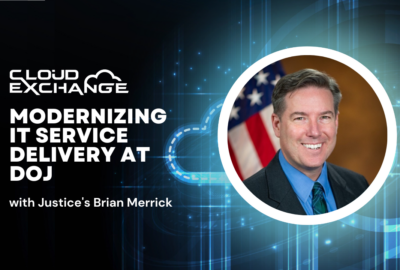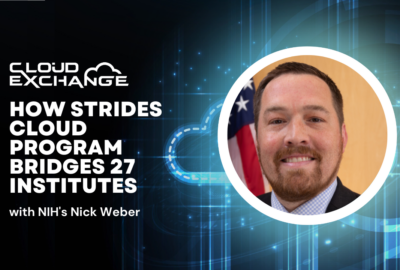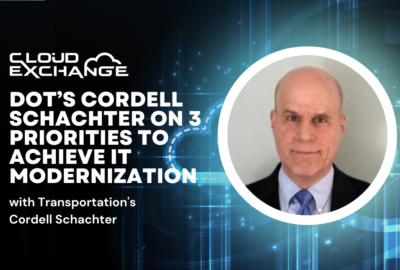

The approaches that agencies used early on to shift services like email to the cloud no longer apply, say cloud experts from AWS, Commvault and Kelyn Technologies.
Most agencies have already checked off the low-hanging fruit on their cloud roadmaps. Moving capabilities like email and collaboration tools happened years ago.
Now, though, agency IT teams have begun to realize the processes they followed for those maiden cloud efforts may not work as well for current cloud moves or for cloud services planned for the future.
During the Federal News Network Cloud Exchange 2023 , a panel of clAWSoud experts from Amazon Web Services, Commvault and Kelyn Technologies laid out a recipe to help agencies evolve how they approach cloud adoption now. The three companies regularly partner to work with agencies on cloud initiatives.
Most agencies have an assortment of applications, and IT teams therefore need a few strategies for making the best use of cloud, said Ryan Lake, chief technology officer of Kelyn Technologies.
Some apps the agency owns, which Lake said are easier to move to the cloud.
“There’s certain classes of applications that can be classified very easily, and they may not be the first ones to move, but once they get there, they adopt the cloud mindset, they take on best practices, and they become very natural guests of that cloud,” he said.
Others may be commercial off-the-shelf applications, which might or might not be supported by their vendors any longer. Those will take more resources and know-how to move off premise, Lake said. Finally, there are applications that agencies may well be forced to live with on premise for the foreseeable future because they are mission critical and can’t be moved to the cloud.
“You’re either going to keep it on premise or you’re going to move it to the cloud and lift and shift it because you’re not going to be able to refactor it,” he said. “You don’t own it, you didn’t make it, and you’re not in a place to replace it. We’ve had a lot of success working with customers about coming up with models. We can build these services around it to help you make it as resilient as possible, to help you keep your data protected and to help you keep that application as cloudified as it’s going to get because you’re not going to be able to redo it.”
Agencies have the opportunity to embrace containers, such as Kubernetes, as a way to create velocity in achieving capabilities rapidly without having to move everything to the cloud, said Richard Breakiron, senior director for strategic initiatives for Americas public sector at Commvault.
This tack also will help close the gap between managing on-premise applications and those the agency has moved to the cloud, Breakiron said.
But a common challenge is people, he said.
“They have people that know the on-premise, but they don’t understand totally cloud. They’re trying to learn that, and they’re trying to learn it with the right team, which I think that’s been a core theme,” Breakiron said. “How do you build a team of people that you can build trust in — even if you may not know, coming out of the gate with this new shiny object, how it’s all going to work together? But there are people out there who have gone through the hard knocks a little bit, so the key is: How do I get the right people? I think that consistently is where government struggles.”
Lake added that the need for constant learning is a common theme among companies too. He said no certification class can prepare anyone for what happens when you sit down and begin moving systems to the cloud.
Each application and each system is often so different, that no matter how much an agency prepares, there still will be challenges, said Sean Phuphanich, a principal solutions architect for Amazon Web Services. That makes adequate planning a key success factor for agencies, he said.
“Cloud has no competition when you’re talking about rate of change, especially when you’re trying to modernize and especially when you’re trying to build new things. That’s where that environment really just gives you so many more tools than you would ever have available,” Phuphanich said. “It’s the benefit of the economies of scale. You have thousands of customers on the same platform that you can continue to upgrade, even if they’re not asking for it.”
The ideal cloud recipe, the three panelists said, includes facets of the three components they identified:
Phuphanich said if agencies do those three things, they will succeed in getting the benefits available from cloud.
To read or watch other sessions on demand, go to our 2023 Cloud Exchange event page.
Copyright © 2025 Federal News Network. All rights reserved. This website is not intended for users located within the European Economic Area.




Senior Director for Strategic Initiatives, Americas Public Sector, Commvault

Principal Solutions Architect, Amazon Web Services

Chief Technology Officer, Kelyn Technologies

Executive Editor, Federal News Network

Senior Director for Strategic Initiatives, Americas Public Sector, Commvault
Richard Breakiron is Commvault’s Senior Director, Strategic Initiatives, Americas Public Sector focused on the Federal community. He gained his extensive experience in developing, deploying and operating critical network IT and large data management systems while serving as an officer the Army, senior government civilian with the Army and DISA and U.S. security agencies.
A leader on many major IT program initiatives throughout his career, Richard oversaw the largest Base Realignment and Closure (BRAC) effort comprising over $3 billion in IT systems to support a $16 billion transformation of Army infrastructure. He further led the effort to realign the DoD’s Top-Level Architecture, by building a partnership with the DoD CIO and AFSPACECOM. While at the Pentagon with HQDA CIO/G-6, he served in leadership roles for strategic initiatives managing an Army-wide IT reform and network modernization effort.
Richard works alongside his Strategic Initiatives counterpart, Dave DeVries, where they both bring their close to 80 years of collective experience and insights from the DoD and Federal agencies to the states and local government as well as higher education. Since leaving government service, Mr. Breakiron has held positions as Executive VP, Public sector, root9B, an advanced Cyber security company; Senior Director, Cyber solutions for ViON Corporation; and initiated the standup of Ascolta, LLC, a data analytics subsidiary of ViON, as their General Manager and served on the board of Ascolta.
Richard and his wife are fortunate to enjoy a great rural life in Aiken, SC. They relax by gardening, do-it-yourself projects, playing tennis, an occasional Top Golf, and are learning sailing and scuba to enjoy their regular travel to SC beaches with their three ‘launched’ children.

Principal Solutions Architect, Amazon Web Services

Chief Technology Officer, Kelyn Technologies
Ryan is a technology enthusiast who found his passion in Information Technology after receiving a BSCE from the University of Colorado. He worked as an Unix systems engineer in the semiconductor industry designing and implementing solutions to many of the real world problems organizations face today.
After joining Kelyn he has strived to help customers find real value in the fast changing IT landscape with a holistic multi-disciplinary approach. In his free time Ryan is an avid mountain biker and perpetual tinkerer.

Executive Editor, Federal News Network
Jason Miller has been executive editor of Federal News Network since 2008. Jason directs the news coverage on all federal issues. He has also produced several news series – among them on whistleblower retaliation at the SBA, the overall impact of President Obama’s first term, cross-agency priority goals, shared services and procurement reform.
